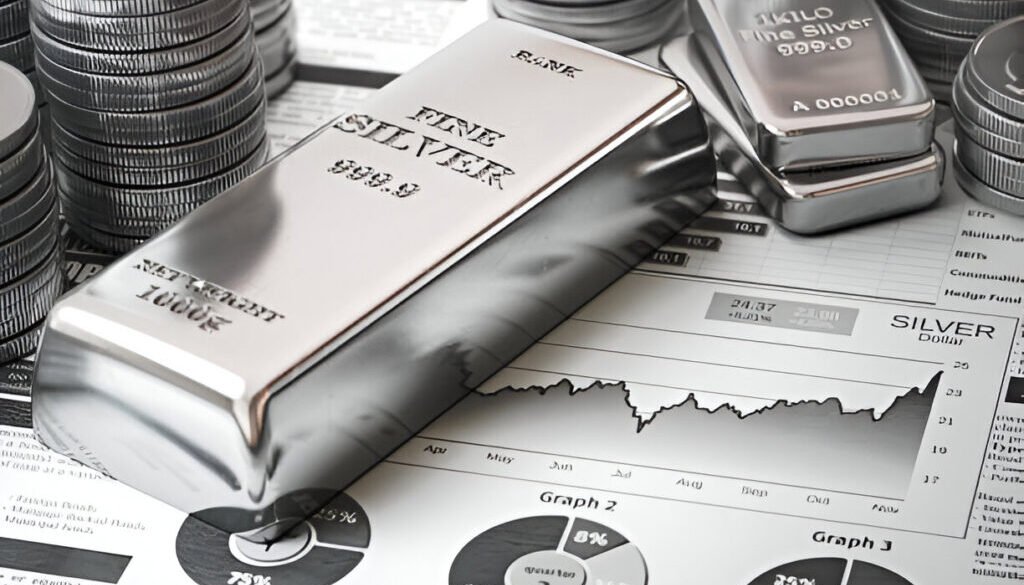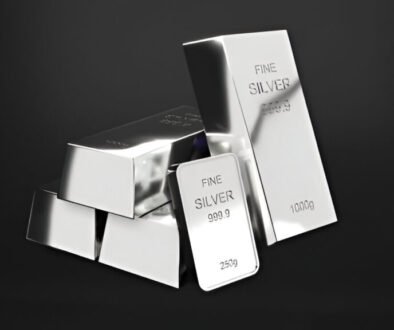Why Silver in a Self Directed IRA Could Be the Smartest Move of 2025
Silver isn’t just shiny—it’s strategic. See how silver in a Self Directed IRA can strengthen your retirement strategy.
Silver is often overlooked, but its affordability makes it a perfect fit for Self-Directed IRA investors wanting to diversify smartly.
What is A silver IRA?
A Silver IRA is a special type of IRA that allows you to invest in physical silver bullion, rather than traditional investments like stocks and bonds. One of the main benefits of investing in a Silver IRA is that it allows you to diversify your retirement portfolio and protect your savings against inflation.
How Does a Silver IRA Work?
A Silver IRA is a type of self-directed individual retirement account (SDIRA) that allows you to invest in physical silver, along with other IRS-approved precious metals like gold, platinum, and palladium. Many investors in 2025 are turning to silver IRAs as a way to diversify their retirement portfolios and protect against inflation, market volatility, and currency risk.
Like Traditional and Roth IRAs, a Silver IRA offers tax advantages, but with the added benefit of holding tangible silver in a regulated account. These accounts give you greater control over your investment choices, while still requiring you to follow IRS rules.
To set up a Silver IRA, you’ll work with two key entities:
- A Self-Directed IRA custodian, who manages the account and ensures IRS compliance
- A precious metals dealer, who helps you select and purchase IRS-approved silver products
Once your Silver IRA is open and funded—either through a rollover, transfer, or direct contribution—you can begin purchasing silver in the form of bullion bars, coins, or rounds. The IRS requires the silver to be at least .999 fine and produced by approved mints.
2025 Contribution Limits
For 2025, the IRS contribution limits remain the same as in recent years:
- Up to $7,000 per year
- Or $8,000 if you’re age 50 or older
Your contributions may be tax-deductible (Traditional IRA) or after-tax (Roth IRA), depending on the account type you choose and your income level.
Secure Storage Requirement
One of the most important IRS rules: your silver must be held in an approved depository. These secure storage facilities are regulated and insured to protect your physical assets. Home storage is not allowed if you want to maintain the tax-advantaged status of your IRA.
Withdrawal Rules
Withdrawals from a Silver IRA follow the same rules as standard IRAs:
- Penalty-free withdrawals start at age 59½
- Early withdrawals typically incur a 10% penalty plus income taxes, unless an exception applies
A Silver IRA isn’t for everyone, but if you’re looking to add real, tangible assets to your retirement plan in 2025, it could be a smart long-term hedge. Be sure to consult with a qualified financial advisor or retirement specialist to see if it fits your overall strategy.
Types of Silver IRAs
There are several types of Silver IRA options available, each offering different levels of control and flexibility.
1. Traditional Silver IRA
This is the most common type. It works just like a traditional IRA but allows you to hold physical silver instead of paper assets like stocks or bonds. Contributions may be tax-deductible (depending on your income), and your silver grows tax-deferred until you start taking distributions in retirement. If you’re looking to reduce your taxable income now and don’t mind paying taxes later, this option makes sense.
2. Roth Silver IRA
A Roth Silver IRA also allows you to invest in physical silver, but it’s funded with after-tax dollars. That means you won’t get a tax deduction today, but your silver can grow tax-free, and qualified withdrawals in retirement won’t be taxed. This is a smart choice if you expect to be in a higher tax bracket later or if you’re younger and have more time to let your silver appreciate.
3. SEP Silver IRA
Designed for self-employed individuals and small business owners, a SEP (Simplified Employee Pension) Silver IRA allows higher annual contributions than a traditional or Roth IRA. Like a traditional IRA, your contributions are tax-deductible, and your silver grows tax-deferred. It’s a great option if you want to make larger silver investments each year.
4. SIMPLE Silver IRA
SIMPLE (Savings Incentive Match Plan for Employees) IRAs are typically used by small businesses with fewer than 100 employees. A SIMPLE Silver IRA lets both employers and employees contribute toward retirement using physical silver. It’s a more limited option, but still viable if you’re running a small company and want to offer precious metal retirement benefits.
Benefits of Investing in Silver in a Self Directed IRA
Investing in silver through an IRA can offer several benefits, such as diversifying your retirement portfolio, protecting against inflation, and potentially earning higher returns than traditional investments. Silver has historically been an effective hedge against inflation and has the potential to provide a higher return on investment than traditional IRA options like stocks and bonds. Additionally, owning physical silver can provide peace of mind during times of economic uncertainty and can offer a tangible asset that you can hold onto during times of crisis.
1. Diversification Beyond Traditional Assets
Silver adds a non-correlated asset to your retirement portfolio. Unlike stocks or bonds, silver often moves independently of the broader market, helping to reduce overall portfolio risk and volatility.
2. Hedge Against Inflation and Currency Devaluation
Precious metals like silver have historically retained value during times of inflation, economic uncertainty, and declining purchasing power. Holding silver in a Self-Directed IRA can serve as a long-term hedge against the dollar’s weakening and rising consumer prices.
3. Physical Ownership with Tax Advantages
When held in a Self-Directed IRA, you get the benefits of owning physical silver—not just paper-based exposure—while enjoying tax-deferred (Traditional) or tax-free (Roth) growth. This makes it possible to protect your wealth without losing tax efficiency.
4. Affordability and Accessibility
Compared to gold, silver is more affordable per ounce, making it easier to acquire meaningful quantities without a large upfront investment. It’s a great entry point for investors who want to hold hard assets without overcommitting their portfolio.

Pros and Cons of Silver IRAs
Let’s now consider the advantages and disadvantages of a Silver IRA. One of the primary advantages of a Silver IRA is its tax benefits. Like traditional IRAs, contributions to a Silver IRA are tax-deductible, which can help you reduce your taxable income.
✅ Pros of Silver IRAs
1. Portfolio Diversification
Silver offers an alternative to paper assets like stocks and bonds. Including silver in your IRA helps balance your risk and adds a layer of protection during market volatility.
2. Hedge Against Inflation and Currency Risk
Precious metals like silver tend to hold their value when the dollar weakens or inflation rises. This makes silver a smart hedge against economic uncertainty.
3. Tax Advantages
Like traditional or Roth IRAs, a Silver IRA offers tax-deferred or tax-free growth, depending on your account type. You can grow your investment without paying taxes every year.
4. Physical Asset Ownership
Unlike ETFs or mutual funds, a Silver IRA gives you exposure to real, tangible silver. It’s a hard asset with intrinsic value, not just a number on a screen.
5. Greater Control Through a Self-Directed IRA
With a self-directed IRA, you have more say in your investment choices. You can buy silver bars, bullion, or coins that meet IRS requirements.
❌ Cons of Silver IRAs
1. Storage Fees and Custodian Costs
Because you’re dealing with physical silver, you’ll need to pay for secure, IRS-approved storage and custodial services. These fees can add up over time.
2. Strict IRS Rules
The IRS sets specific guidelines for purity, storage, and approved dealers. If you violate them (like storing silver at home), your IRA could lose its tax-advantaged status.
3. Market Volatility
Silver prices can be unpredictable. While it’s a good hedge in many cases, silver is also more volatile than gold, which can impact short-term value.
4. No Immediate Income
Silver doesn’t produce dividends or interest. If you’re looking for regular income in retirement, a silver IRA may not provide that unless you sell portions of your holdings.
How to Invest in a Silver IRA
So, how can you invest in a Silver IRA? The first step is to choose a custodian who specializes in precious metals IRAs. This custodian will help you set up a self-directed IRA account and assist you in purchasing physical silver to hold in your account. It’s important to note that not all silver is eligible for a Silver IRA. Only certain types of silver, such as American Silver Eagles, Canadian Silver Maple Leafs, and bars produced by approved mints, are allowed. Your custodian will be able to provide you with a list of eligible products.
Choosing a Silver IRA Provider
It’s important to choose a reputable and trustworthy provider to hold your silver IRA. Look for a provider with a good track record, competitive fees, and a wide variety of silver options to choose from. Additionally, it’s a good idea to choose a provider that offers segregated storage, which means that your silver will be stored separately from other clients’ assets, providing added security and peace of mind.
If you are not sure Get
Once you have chosen a provider, you will need to fund the account with cash or by rolling over assets from another retirement account. The process of setting up a Silver IRA is relatively straightforward and can typically be done online.
since you have set up your Silver IRA, you can then decide how much of your portfolio to allocate to silver. This will depend on your investment goals, risk tolerance, and overall financial situation.
Silver Eligibility
Not all types of silver are eligible for an IRA. The IRS has specific guidelines on what types of silver are allowed in a Silver IRA. Purity Standard: Silver must be 99.9% pure (.999 fine) to qualify.
- Approved Storage: Silver must be stored in an IRS-approved depository—home storage is not allowed.
- Qualified Custodian: You need a Self-Directed IRA custodian to manage your account and ensure compliance.
- No Collectibles: Collectible or numismatic coins are not allowed—stick to IRS-approved bullion only.
- Contribution Limits: Up to $7,000/year, or $8,000 if you’re 50+, across all your IRAs.
- Withdrawal Rules: No penalty after age 59½; early withdrawals usually face a 10% penalty + taxes.
Common eligible silver items include:
- American Silver Eagles
- Canadian Silver Maple Leafs
- Austrian Silver Philharmonics
- Certain silver bars from approved refiners (like Johnson Matthey, PAMP Suisse, etc.)
Storage
Silver IRA custodians typically offer different options for storing the silver, including allocated storage, unallocated storage, and home storage. Allocated storage means that the silver is stored separately from other clients’ assets and is allocated to your specific account. Unallocated storage means that the silver is stored with other clients’ assets and is not allocated to a specific account. Home storage is a special type of storage where you can take physical possession of the silver and store it in your own safe or deposit box.
Taxation
The taxation of silver IRA is similar to traditional IRA. Contributions to a silver IRA may be tax-deductible and the money in the account can grow tax-free until you withdraw it in retirement. Once you begin taking distributions, the money is taxed as ordinary income.
Things to consider before investing in a silver IRA
Before investing in a Silver IRA, make sure you understand the IRS rules, including the requirement to store silver in an approved depository—you can’t keep it at home. You’ll need to choose a qualified Self-Directed IRA custodian and a trustworthy precious metals dealer, as not all institutions handle physical silver. Only IRS-approved silver, like .999 fine bullion and certain coins, is eligible—collectibles are not allowed. Also, be aware of the various fees involved, such as setup, annual maintenance, storage, and dealer markups. Silver can be more volatile than gold, so consider your risk tolerance and investment horizon. Silver IRAs are better suited for long-term investors seeking diversification and inflation protection.




What Is a Silver IRA Rollover and How Does It Work in August 2025 - GWI
August 3, 2025 @ 1:00 pm
[…] portfolio and protect your savings from Market volatility a silver Ira could be a smart option. A silver Ira is a self-directed individual retirement account that allows you to invest in physical silver as opposed to traditional assets like stocks bonds or […]
Top 5 Silver IRA Mistakes New Investors Make (And How to Avoid Them) - GWI
August 3, 2025 @ 3:16 pm
[…] in a Silver IRA can help you hedge against inflation, diversify your retirement savings, and protect your wealth […]